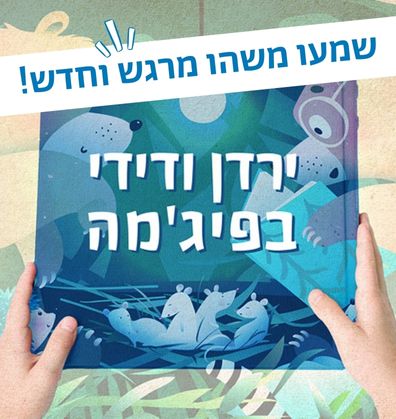סְּפָרִים
Book-Related Family Activities
Discussion
Who are your friends? What do you like doing together? You can have a conversation about this and look into these questions: Do you like sitting together with other people quietly, like the penguin? Perhaps you like running, like the tortoise? How about thinking together about how you can bring some joy to friends who need you.
What story do the pictures tell?
Through the unique drawings in the book, you can read the story together even on the pages that have no words. Look, together, at the pages with the drawings, and tell each other what those drawings are expressing. Is there an illustration that you liked in particular?
Hello, Red Balloon
Which drawings does the red balloon appear in? When does it disappear? You can look for it in the book, and play some games with balloons, too, like hitting a balloon between your hands, tossing it into the air and trying to prevent it from touching the floor, or inflating it , releasing the air, and seeing where it ends up.
Visiting the sick
Amos McGee takes care of his friends, and they take care of him when he’s sick. Think along with your children about how you can make a sick friend or relative happy (through a phone call, a hand-drawn card, a small gift, and more).
Pinterest – Arts and crafts suggestions on the book’s page in PJLibrary’s Pinterest account

A childhood song – The Little Bunny [HaShafan HaKatan]
This book was inspired by the well-known children’s song The Little Bunny [HaShafan HaKatan] by Binyamin Caspi. You may want to ask your child which children’s song this story reminds them of, and then sing and dance together.
Do you have any other favorite children’s songs? You could create a family songbook, and select one to sing together from time to time. You too may be inspired to write a story about it.
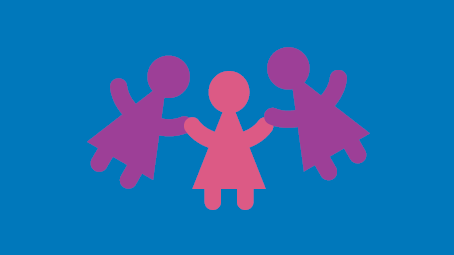
Where are you in this story?
Reading both words and illustrations – You may enjoy taking turns reading this book to one another: you can read the words to your child, and then have them tell you the story using the illustrations.
Our table – draw an empty table and choose who to invite over: it can be family and friends, real or imaginary, favorite toys, or characters in books. What would you serve your guests? What do you think would happen when they all meet one another?

Inviting people round
Having a friend visit us is exciting. You may want to prepare for the visit together and discuss how to welcome this friend, how to pass the time together when they get here, and what to do if each of you prefers to do something else.

Kind words in our family
The bunny’s friends thank him, and he uses kind words when speaking to them, like “please”, “so glad you came over”, and “bon appetit!”. When you sit together for a family meal, you could take turns saying kind words to each other: the first begins by giving the one on their right a compliment; the second compliments the third, and so on. The compliment can be about something nice they had done, a good quality they have, having behaved pleasantly, or any other positive thing you can think of. If you look for it, you’ll be sure to find it…
Proposed Family Activities:
- Pepper’s nose is blocked and he has a terrible cold (or as the Hebrew original puts it “betsudad dora”). Can you understand what he says? Try blocking your nose and reading Pepper’s dialog. You could also ask your child to translate “cold” into Hebrew, and invent new “cold” words.
- The story is long and suspenseful. You may want to pause at the point where Joezer announces “We’re in trouble”, let your child guess the rest of the plot, and resume reading another day.
- You could ask your child who, in their opinion, had invented the story – Jo or Pepper? You may also enjoy making up your own story, and taking turns to do so. Start the first sentence, then ask your child to add one of their own. Keep going, taking turns, until an entire story comes together. You could even write it up, and draw some illustrations to go along with it.
- Pepper (as well as Marheshvan) is a funny name for a bunny! Does your child know that the month of Heshvan is also called Mar-Heshvan? Mar is Aramaic for drop, and during the month of Heshvan we expect rainfall. Some say the word Mar was added to the name of this month because it is the only one in which we do not mark a single Jewish holiday or fast day. Can your child name all the Hebrew months of the year? You may want to check the Hebrew birthdays of all your family members, and create a Hebrew birthday calendar for the entire family.
- Are any of your child’s classmates unwell? Perhaps someone around you is feeling a little sick? You could think of ways of making them feel better together, like making them a hand-drawn greeting card, calling them, taking over something yummy, or properly visiting them, story and all!
Proposed Family Activities:
- You may want to read this story several times, and look at the special illustrations together. You could ask your child: how can you tell from the illustration that Guy is not feeling well? How does each member of his family try to help him get better? You could search for pictures of Yoyo the dog, and ask what it is doing on each page. Perhaps your child could tell you the story in their own words according to the illustrations.
- Mom, Dad, Grandma, Grandpa and Yoyo try to cheer Guy up and make him happy. Each of them does what they can and think is best for him. You may want to share a memory with your child of a time when you had gone to visit a sick person, or a time when you were sick and received a heartwarming visit.
- Often children are unable to visit the sick, but they can still help them recover, and cheer them up. Do you happen to know anyone who is unwell? You could encourage your child to draw a greeting card for them, call them up, or make something yummy for them, to try and help them get well.
- Perhaps you would enjoy opening a “toy clinic” at home in which to treat your dolls and stuffed animals. You could also play together: you could be the patient, and your child could pretend to be your doctor, or vice versa.
- Grandpa makes sweet, hot tea for Guy. You can also make delicious herbal tea, if you like, to warm up your entire family: place some herbs in a teapot (mint, rosemary, lemongrass or sage), pour boiling water over them, and sweeten the hot beverage. Enjoy!
Family Activities:
- Ruthi proclaims that “there’s no other coat like this in the world!” You may ask your children what it is that makes Grandmother’s coat so special. Ask them to describe the coat in their own words. Don’t forget to note the soft material and the surprise-laden pockets! Do you have special clothes or objects that help you feel better? This is an opportunity to remind children of blankets, stuffed animals or a special cloth that help them feel calm in times of distress.
- Dressing up in costume is a wonderful way to foster one’s imagination. You can provide old clothes, hats and other props to encourage your children’s make-believe play. You may dress up in a big old coat and, adding a few other relevant props, can act out the story together.
- Many of us have childhood memories connected to touch. Do you too have a distant recollection of a special piece of clothing? You can share this childhood memory with your child and tell them about the special connection you had with the clothing, or with your grandparents, aunts or uncles.
- The “It’s Like” game: The author Miriam Roth compares the feel of Grandmother’s coat with the fur of a cat. You can make up a word game to play with your children: Place objects made from different materials – e.g., metal, plastic, cloth, etc. – into a large bag. One by one, each player removes an object from the bag and describes the object declaring “It’s soft like…”, “It’s cold like…”, “It’s coarse like…”
- Ask your child to show you the picture depicting Ruthi sick in bed. You can ask them how they feel when they’re sick. What helps us feel better? Do you have any special “family remedies” that were passed down from generation to generation? You can ask a grandparent, aunt or uncle what they recommend to overcome a sad mood or a mild cold.
-
If your child has a grandparent, aunt or adult friend who lives nearby, reading the story together could be a special treat for both of them, and lead to closer relations between the generations.
Miriam Roth
Miriam Roth (1910-2005) was a well-known children’s author and educator. In 1998 she won the UNICEF Smile Award for her book “A Tale of Five Balloons”, and in 2002 was awarded the prestigious Bialik award for literature. Roth’s books include Israeli children’s classics such as “Tiras Cham”, “Maaseh shel Hamisha Balonim”, and “Habayit shel Yael”.
Family Activity
- Bear’s friends try to cheer him up and make him happy. Each one of them does their best. But how do they do it? Pick one animal and focus on its actions throughout the book. What kind of help does this animal give Bear?
- Have you ever visited a sick friend or relative? Did anyone ever visit you when you were not feeling well? How can we cheer up our kindergarten friends when they are sick?
- The badger gives Bear a herbal tea to drink, made from the medicinal herbs picked by Bear’s friends. You can also make a delicious, warm, herbal tea for your family: Put some herbs like mint (nana), rosemary, lemon verbena, or sage in a teapot. Add four cups of hot water and some honey. Pour a cup of tea for every family member and decorate it with a lemon slice.
- Play “make believe sick”: practice the mitzvah of visiting the sick with your family. Let your child take care of you and help you relax. Tell them what helps you when you’re not feeling well. This is a golden opportunity to remind your children that they have the power to heal others!
- At the end of the story, Bear gets better, and finds out that the friends who helped him recover are all sick! How does Bear “know” to take care of his friends, and how does he manage to take care of so many friends at once? Using stuffed animals or dolls, make a small play showing how Bear takes care of his friends.
“You must exercise great caution concerning your lives” Venishmartem meod lenafshotechem
Sickness is a part of life. We get better thanks to the treatment we receive, as well as thanks to our body, which manages to overcome the illness. In the book of Deuteronomy (Devarim), chapter 4 verse 15, it is written: “You must exercise great caution concerning your lives” (venishmartem meod lenafshotechem). This means that we have the responsibility to take care of our body and maintain a healthy lifestyle.
- How do you take care of your body? Discuss: How do you keep the body clean? What kind of food is healthy? How can we use our body to make it stronger? How do we rest to regain energy?
- Bear’s illness is contagious. Try to think how we can be careful to avoid getting infected (for example: washing our hands, not coming to kindergarten when we are sick). What more can we do?

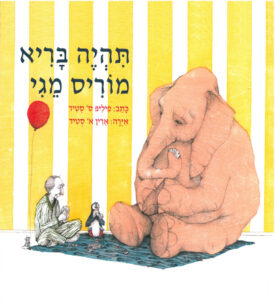 A Sick Day for Amos McGee
A Sick Day for Amos McGee 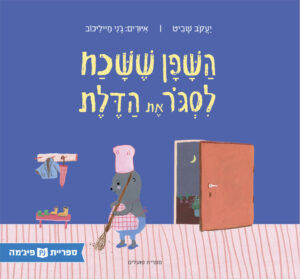 The Bunny who Forgot to Close the Door
The Bunny who Forgot to Close the Door 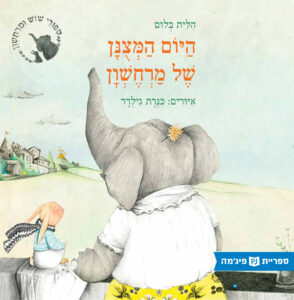 Jo and Pepper and the Big Sleep
Jo and Pepper and the Big Sleep 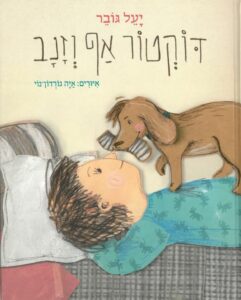 Doctor Yoyo
Doctor Yoyo 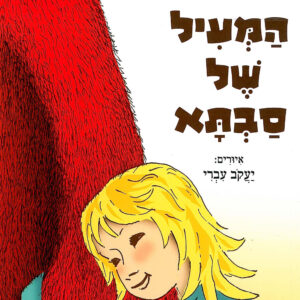 Grandmother’s Coat
Grandmother’s Coat 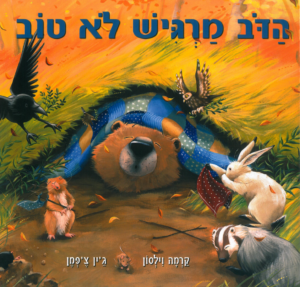 Bear Feels Sick
Bear Feels Sick 

